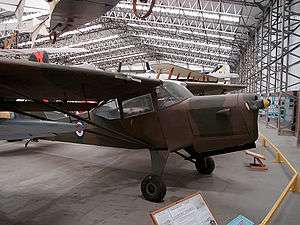No. 666 Squadron RAF
No. 666 Squadron was a Royal Air Force Air Observation Post (AOP) squadron associated with the Canadian 1st Army and later part of the Royal Auxiliary Air Force. Numbers 651 to 663 Squadron of the RAF were Air Observation Post units working closely with British Army units in artillery spotting and liaison. A further three of these squadrons, 664–666, were manned with Canadian personnel. Their duties and squadron numbers were transferred to the Army with the formation of the Army Air Corps on 1 September 1957[4][5]
| No. 666 (Scottish) Squadron RAuxAF | |
|---|---|
.jpg) Insignia of the No. 666 Squadron | |
| Active | 1 May 1949 – 10 March 1957 |
| Country | |
| Branch | |
| Role | Air Observation |
| Part of | No. 66 (Scottish) Group RAF, Home Command |
| Motto(s) | Latin: Speculatus ascendimus (Translation: "We ascend to observe")[1] |
| Insignia | |
| Squadron Badge heraldry | Badge: In front of two gun barrels in saltire, a lion rampant charged with the Cross of St. Andrew[1] |
| Squadron Codes | ROG (May 1949 – Apr 1951)[2][3] |
| Aircraft flown | |
| Reconnaissance | Auster AOP.6 |
History
Formation and World War II
No. 666 Squadron RCAF was first formed on 5 March 1945[1] at RAF Andover as an air observation post (AOP) squadron associated with the Canadian 1st Army. After a period working together with the Canadian army and later with the occupation forces in Germany the squadron disbanded on 30 September 1946.[1][6]
Post-war
As the number was not transferred to the Canadian authorities, it was revived post-war when the squadron was reformed as No. 666 (Scottish) Squadron RAuxAF, part of the RAuxAF on 1 May 1949 at Scone. Equipped with Auster AOP.6 aircraft, the squadron's headquarters was located at RAF Perth/Scone, with three detached flights, Nos. 1966, 1967 and 1968 Flight RAF[7] at respectively RAF Perth/Scone, RAF Renfrew (later RAF Abbotsinch) and RAF Turnhouse,[1] before it was disbanded on 10 March 1957 by transferring to the Army Air Corps.[8]
Present
The squadron was represented by 666 Squadron of 7 (Volunteer) Regiment, Army Air Corps until 1 April 2009.[9]
Aircraft operated

| From | To | Aircraft | Version |
|---|---|---|---|
| June 1949 | November 1951 | Auster | AOP.5 |
| June 1949 | February 1957 | Auster | AOP.6 |
Squadron bases
| From | To | Base | Remark |
|---|---|---|---|
| 1 May 1949 | 10 March 1957 | RAF Perth/Scone, Perth and Kinross, Scotland | No. 1966 Flight RAF |
| 1 May 1949 | 10 March 1957 | RAF Turnhouse, Edinburgh, Scotland | No. 1968 Flight RAF |
| 1 December 1951 | 5 December 1952 | RAF Renfrew, Renfrewshire, Scotland | No. 1967 Flight RAF |
| 5 December 1952 | 10 March 1957 | RAF Abbotsinch, Renfrewshire, Scotland |
Fictional service
A fictional 666 Squadron featured in the Air Ace Picture Library story The Bomber Barons. This 666 Squadron was a bomber unit founded at the outbreak of World War II, operating Handley Page Hampdens (September 1939 – December 1940), Avro Manchesters (January 1941 – 1942), Avro Lancasters (1942–1944) and Avro Vulcans (1960s – 1982).[10] In the long-running series of 'Biggles' books by W.E. Johns, 666 Squadron, RAF, is the Special Duties squadron led by the eponymous hero James Bigglesworth during World War II. In the Charles Stross novel "The Fuller Memorandum" 666 Squadron is a secret RAF unit involved on occult activities.
References
Notes
- Halley 1988, p. 451.
- Bowyer and Rawlings 1979, p. 138.
- Flintham and Thomas 2003, p. 187.
- Halley 1988, p. 444.
- Jefford 2001, pp. 102–105.
- Jefford 2001, p. 105.
- Sturtivant and Hamlin 2007, p. 131.
- Barrass, M. B. (2015). "No. 651–670 Squadron Histories". Air of Authority - A History of RAF Organisation. Retrieved 14 October 2015.
- "666 Squadron". British Army units from 1945. 2015. Retrieved 19 October 2015.
- Air Ace Picture Library Holiday Special 1982.
Bibliography
- Bowyer, Michael J.F. and John D.R. Rawlings. Squadron Codes, 1937–56. Cambridge, UK: Patrick Stephens Ltd., 1979. ISBN 0-85059-364-6.
- Flintham, Vic and Andrew Thomas. Combat Codes: A full explanation and listing of British, Commonwealth and Allied air force unit codes since 1938. Shrewsbury, Shropshire, UK: Airlife Publishing Ltd., 2003. ISBN 1-84037-281-8.
- Halley, James J. The Squadrons of the Royal Air Force & Commonwealth, 1918–88. Tonbridge, Kent, UK: Air-Britain (Historians) Ltd., 1988. ISBN 0-85130-164-9.
- Jefford, C.G. RAF Squadrons, a Comprehensive Record of the Movement and Equipment of all RAF Squadrons and their Antecedents since 1912. Shrewsbury, Shropshire, UK: Airlife Publishing, 2001. ISBN 1-84037-141-2.
- Rawlings, John D.R. Coastal, Support and Special Squadrons of the RAF and their Aircraft. London: Jane's Publishing Company Ltd., 1982. ISBN 0-7106-0187-5.
- Sturtivant, Ray, ISO and John Hamlin. RAF Flying Training And Support Units since 1912. Tonbridge, Kent, UK: Air-Britain (Historians) Ltd., 2007. ISBN 0-85130-365-X.
